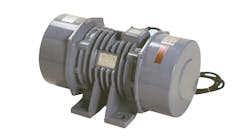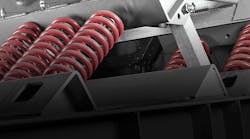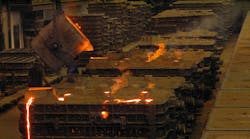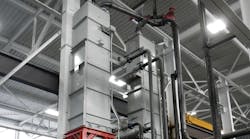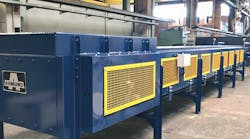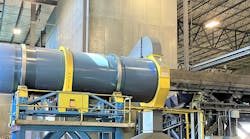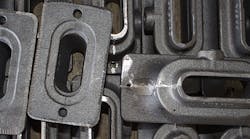Foundries can be amazing places to work. There is no other job quite like it, however, there are a few safety issues that can arise from the noise, dust, and heat of foundries. It’s important to know the facts surrounding the health of you and your employees. Not to mention the solutions that can make your foundry a safer place to work.
Controlling noise — According to the American Foundry Society, hearing loss has affected over 22 million people in the United States with industrial exposure leading the list of causes at 20%. Out of industrial exposure, the rate of hearing loss caused by foundry environments is roughly three times greater than in private manufacturing.
Noise is rated as A-weighted decibels or dBA as perceived by the human ear, many factors can contribute to noise in foundry. To list a few:
• Shakeouts (vibratory or rotary. 105-115 dBA);
• Shot blasting (100-110 dBA);
- Casting and sprue handling via conveyors and feeders (95-115 dBA);
• Cast grinding (92-115 dBA).
The permissible exposure limit (PEL) regulated by The United States Department of Labor is dependent upon the hours of exposure to noise. If working an 8-hour shift the PEL for that time is 90 dBA. The dBA PEL continues to gradually increase as the time spent exposed to noise decreases.
The permissible exposure limit (PEL) for noise
in the workplace, regulated by the U.S.
Department of Labor, depends upon the hours
of exposure to noise. If working an eight-hour
shift, the PEL is 90 dBA. The dBA PEL continues
to increase gradually as the time spent exposed
to noise decreases.
Personal Protective Equipment or PPE may seem like a decent solution to noise exposure, however, in a study by the National Institute of Occupational Safety and Health (NIOSH), PPE has been found to be the least effective. Most reasons cited were that the PPE was uncomfortable, ill-fitted, or flat out neglected.
A more effective option is administrative controls, as it includes completely relocating employees away from harmful noises or the less effective shortening of their shift to reduce exposure.
General Kinematics recommendations to reduce foundry noise levels include:
• Enclosures, which can be helpful for isolating noise away from operators. A popular option is hooded vibratory equipment and sound enclosures that are built directly around the equipment.
• Liners provide iron handling equipment with sound deadening troughs to muffle some of the noise that is projected.
• Keeping equipment operating well and working within the proper stroke range reduces mechanical noise.
• Last but not least, GK Flat-Stroke designed equipment eliminates the sound caused by large material impacts and keeps the castings in contact with the conveyor surface.
Controlling silica dust — Silica dust is a serious issue surrounding the safety of your employees. Crystalline silica dust, or “silica” as it is most commonly called, is fine granite particles caused by manufacturing processes. This fine dust becomes a health hazard when it enters the air and is inhaled into the lungs.
Silica can be a much greater health risk to foundry employees than most would think. In fact, OSHA has moved the permissible exposure limit (or PEL) to 50 μg/m3 over an 8 hour work day for just this reason. Silica dust, when breathed into the lungs, causes scarring to form thus blocking the absorption of oxygen causing other problems such as silicosis, lung cancer, kidney disease, and chronic obstructive pulmonary disease.
Controlling dust in a foundry can be done in many ways similar to those for noise control. GK recommends the following to reduce silica dust in your foundry:
• Ventilator suits — Quarantining the air operator’s breath from the contaminated air in the plant is the quickest and simplest way to ensure they are in a healthy environment.
• Manipulators — Similar to ventilator suits, removing your employees from a hazard is the best way to keep them safe.
• Shakeout Enclosures — A great way to keep silica contained while going through a process that can kick up a lot of dust.
• Automation with the GK Vibra-Drum® Casting Conditioner. This drum effectively cools and conditions sand and castings before they come in contact with people.
Controlling heat — Health hazards for heat are both internal and external. Internal body temperature stressors include anything from heat rash to heat stroke.
External hazards from heat exposure in a foundry may appear in the form of burns and blistering, for example when castings are improperly handled. The industry standard for casting temperature and personal exposure is 180°F (80°C) due to blast temperature limits. If these limits are met or exceeded without the presence of PPE it will result in burns.
Heat radiating from castings may generate an oppressive environment, but the risk also may be contributed to by environmental factors such as humidity and stagnant air. When a worker’s body temperature reaches 100°F (38°C), working conditions are not safe. Work becomes strenuous and measures will need to be taken to increase cooling airflow and reduce heat.
• PPE — Personal Protective Equipment like gloves or air-conditioned suits can protect workers from burns and heat exhaustion.
• Rotations — Rotating operators to limit individual exposure to heat is a great way to reduce exposure.
• Air draft — Improving airflow to cool operators is another way to provide a better environment.
• Conditioned rooms — Having a room where workers may cool off is not only a good idea to keep body temperatures low regularly, but great to have on hand when a worker is suffering from a heat-related illness.
• Cooler castings — Improve your foundry process by installing a GK Spira-Cool® Casting Cooler to ensure castings are cooler before they even reach the operators. This can eliminate the risk of burns completely.
Claude Hutchens is the director, Foundry Market and International Sales for General Kinematics Corp. Contact him at [email protected], or visit www.generalkinematics.com

